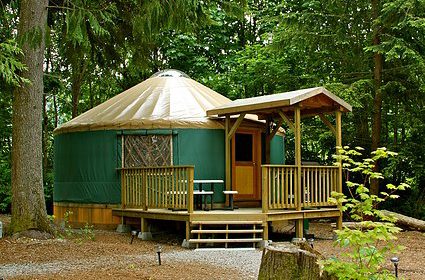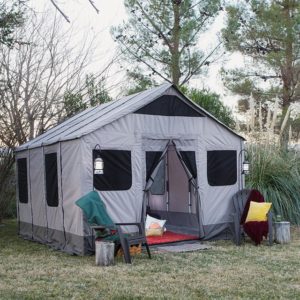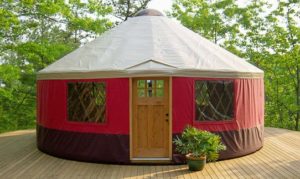★ Livin’ in a Tent and Yurt

As human beings, we are evolving toward a disconnect from our interconnection with nature. We find ourselves forced into a fast-paced, digital, IT-filled world, where we could not, if our lives depended on it, know the name of our neighbours.
There are a select few of us that hear the call of the wild, who yearn to go back in time and live a simple sustained life in partnership with nature.
If you plan to become a homesteader, or already have an acreage of land and are thinking of the options available for temporary or semi-permanent shelter, then listed below are some ideas that others have used. Some of these options may be legal in your region and others may need further investigation.
Pros and Cons of living in a Tent and Yurt
 Tent: A tent is a simple shelter constructed with multiple sheets of animal skins, or fabric material draped over and attached to a frame of poles or supporting ropes pegged to trees or the ground.
Tent: A tent is a simple shelter constructed with multiple sheets of animal skins, or fabric material draped over and attached to a frame of poles or supporting ropes pegged to trees or the ground.
Tents were first used as far back as the early iron-age (between 1200 BC and 600 BC depending on the region ), as portable homes by nomadic peoples. Tents are mentioned in the Bible; for example, Genesis 4:20. Various styles developed over time, some derived from traditional nomadic tents, such as the yurt ( see below ).
The major technological advance in tents was the use of linen or hemp canvas for the canopy, versus leather or felt materials. The primary use of tents was to provide portable shelter for a small number of men in the field. In more modern times tents are more likely to be used as expedition or recreational shelters – camping.
Yurt:
 A Yurt is a style of Tent, a traditional portable round shelter that was used by the Turks and Mongolians during the nomad period. This shelter was traditionally covered with tanned skins or felt and was renowned for its simplicity, durability, and the ease in which the tent could be set up or taken down for travel purposes.
A Yurt is a style of Tent, a traditional portable round shelter that was used by the Turks and Mongolians during the nomad period. This shelter was traditionally covered with tanned skins or felt and was renowned for its simplicity, durability, and the ease in which the tent could be set up or taken down for travel purposes.
A modern yurt is a rounded building that provides its residents with a unique experience to be closer to nature. Modern Yurts are now typically built on a wooden platform and are constructed with durable, modern materials, including steam-bent wooden framing, canvas, tarpaulin, a Plexiglas dome skylight, radiant insulation, wire ropes, or metal framing.
The Pros and Cons of Tent/Yurt Living:
Making the decision to utilise a tent or yurt as a temporary shelter is a personal decision, one that needs to be thoroughly investigated prior to that decision. With this in mind, there are a few suggestions that one can take to determine if a yurt is “the right fit” for your circumstances.
- Try living in a small room in your house or apartment for a month. Modern yurts can be filled with amenities. When built correctly, they are mostly ‘open plan’ but can be designed to have a kitchen and bathroom, that is slightly separated from the living area. However, if you are used to living with your kitchen at one end of your home, your bathroom/s at another, and secluded bedrooms for each member of the family, then living in a yurt might not be right for you. A one-room trial experience is a great way to see if you like living in a space that is interconnected with a smaller degree of privacy.
- Commit yourself to an extended camping trip one summer, for a month. This experiment will afford you a unique opportunity to connect or reconnect with nature. Although camping does provide a slightly different living experience than living in a Yurt, there are similarities. The experience will provide you with an overview of what might be needed to live in a Yurt an extended period of time and will reassure the necessary commitment within you that will be required to live in a smaller space, more simplistic, connected, and a self-sustained type of lifestyle.
- Go on a Tent or Yurt vacation. If you are serious about purchasing a Tent or Yurt to use as temporary shelter, then see if you can first stay in one. Do a Google search with the keywords “Airbnb” “Yurt or Tent” and the location you would like to experience this trial, such as “Tasmania, Australia” or “Yellowstone, USA”.
- Rent a Recreational Vehicle ( RV ). An RV is another great way that you can test out living in a Tent or yurt, without actually purchasing one. But try not to hire a luxury model. In fact, the smaller the better IF you are in it to experiment. Like a Tent ot Yurt, the RV is a portable home that features smaller appliances and amenities. For some individuals, the smaller living space is the ideal choice.
 Do a little soul searching:
Do a little soul searching:
Living in a Tent or Yurt is a life-changing decision. Tents and Yurts provide a simpler lifestyle that can be full of memories and very rewarding. Ask yourself what you truly want to experience from your home. Next, determine if you are seeking a simpler way of life. Perhaps you are interested in downsizing your material possessions so that you can focus on something new.
Ask yourself what your priorities are and what do you truly want to gain in experience and memories. Next, determine if you are seeking a simpler way of life. Perhaps you are interested in downsizing your material possessions so that you can focus on something more important.